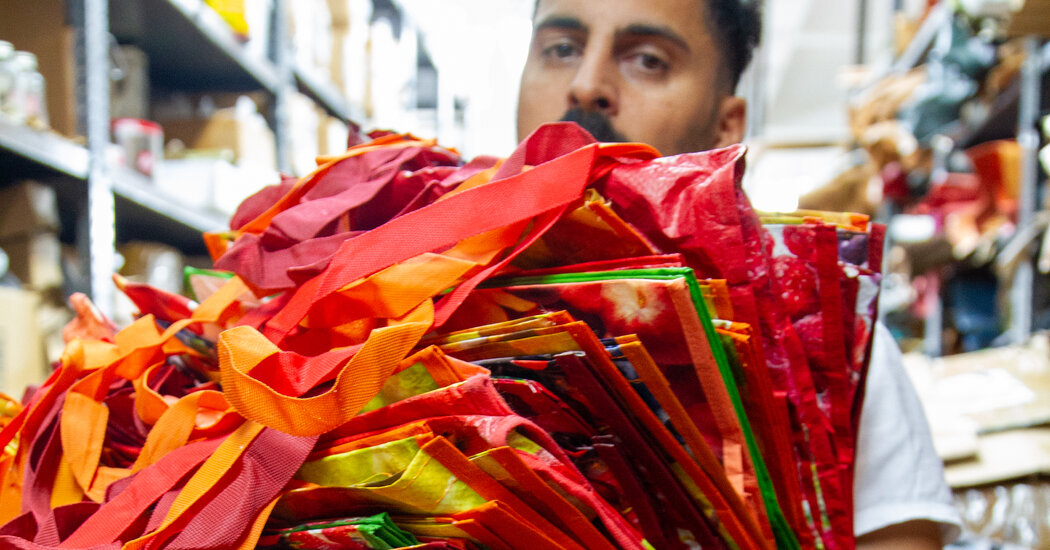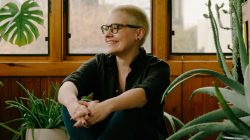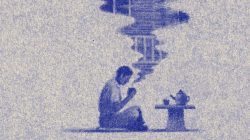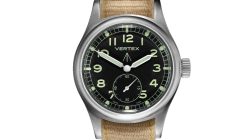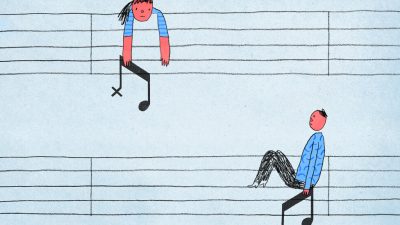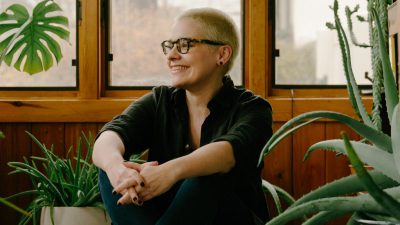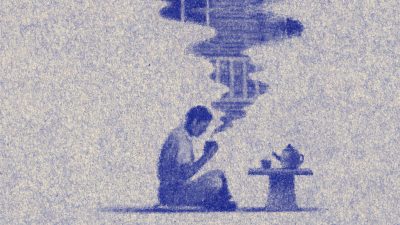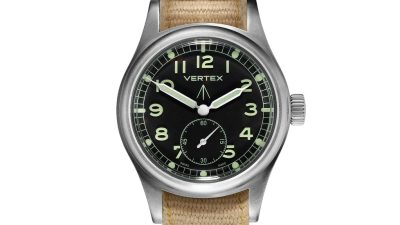This article is part of a series examining Responsible Fashion, and innovative efforts to address issues facing the fashion industry.
Before the pandemic began, leather was a go-to material for the handbag designer Shelley Parker. But when life went remote during the lockdowns, Ms. Parker, 54, couldn’t stand the idea of buying it online. “When I buy leather,” she said, “I touch it, I feel it. I smell it.”
As her leather supply depleted in 2020, Ms. Parker started to experiment with a medium that by then had become more plentiful at her Queens apartment: the colorful plastic totes used to deliver groceries from FreshDirect, which feature the company’s logo surrounded by produce.
“The colors, the patterns, the small text — I like all of that,” said Ms. Parker, an adjunct professor in the accessories design department at the Fashion Institute of Technology and the designer of the accessories line Riveting. “It just speaks to me.”
Ms. Parker began by slicing the FreshDirect bags into pieces. With those scraps, she made a handful of purses and small pouches using techniques including plaiting, macramé and sashiko, a form of Japanese embroidery. “I’m a FreshDirect artist,” said Ms. Parker, who is selling some of the purses for $899 on her website. “I didn’t mean to be, but the bags called to me.”
As more people turned to grocery delivery during the pandemic, others also started using FreshDirect bags as material for design projects.
Colleen Paeff, 54, a children’s book author, used some of the bags to extend a short curtain in her Brooklyn home. “I realized that if I had more, I could have made the entire curtain out of FreshDirect bags,” she said.
After Bailey Constas, 29, used them as packing material when she moved from Brooklyn to Denver, she cut the bags into pieces that she painted and used as the covers for handmade journals, which she is planning to sell at local craft fairs. “I’m just letting the material speak to me,” Ms. Constas, an artist and digital consultant, said of the FreshDirect bags.
FreshDirect was founded in 2002 in Queens, and since then its delivery footprint has grown to include about 21 counties in the tristate area. About 150,000 bags are now used to deliver groceries each week, said John MacDonald, the company’s chief marketing officer. For many years the bags could be returned to FreshDirect, which would recycle some of them. But the company ended that policy in 2020, leaving many people with more bags than they knew what to do with.
It wasn’t long after FreshDirect stopped taking its bags back that Alex Dabagh, whose company Anybag in New York uses plastic bags to make tote bags, heard from people looking to offload their stashes. “They’re reusable but, you know, it’s like, there’s just so much out there,” he said.
“I started getting phone calls and emails from people saying, ‘Hey, we have all these FreshDirect bags piling up in our house, in my apartment, in my kitchen. I don’t have any more space for them,’” Mr. Dabagh, 40, added.
He began to collect FreshDirect bags and turned four of them into a $133 Anybag tote. Since then Mr. Dabagh has acquired between 300 to 400 more FreshDirect bags, which he plans to use as material for a future collection of totes.
FreshDirect’s bags are designed by its marketing team, which chooses and photographs the produce that appears on them. New designs are introduced seasonally to reflect the types of fruits and vegetables that may be inside the bags when they arrive at customers’ doors. (Spoiler alert: Summer 2023 is all about corn.) “The bags kind of express some of the personality of the brand,” Mr. MacDonald, of FreshDirect, said.
Though they are made using recycled plastic, the bags are “not easily recycled,” said Vincent Gragnani, a spokesman for the New York Department of Sanitation. Mr. MacDonald said that one reason FreshDirect stopped taking back its bags was that the recycling process was inefficient and created waste. “We don’t want to bring the bags back in, and then reuse them, because that’s not something that we want to do,” he added, noting that the company is instead “exploring a whole bunch of different things” it could do with the bags people don’t want.
Last year, FreshDirect partnered with organizations that will accept its customers’ bags as donations. Those organizations include the Brooklyn Book Bodega, which uses the bags to distribute books to children, teenagers and schools, and The Red Door Place, a food pantry and soup kitchen in Manhattan that uses the bags to distribute groceries.
“Trying to purchase bags online would have taken a big chunk of our already tightly strained budget,” said Teresa Concepción, executive director of The Red Door Place. “Honestly the bags have made the difference,” she said.
While people like Ms. Concepción see benefits in the abundance of FreshDirect bags, others like Theda Sandiford, 52, an artist and the senior vice president of commerce and digital at Def Jam Records, cannot look at the bags without being reminded of the pandemic during which they proliferated, and the grief and stress that it has caused. To help process those feelings, Ms. Sandiford sliced up FreshDirect bags that she had collected from the trash room of her apartment building in Jersey City, N.J., and wove the pieces through shopping carts to create artworks for a series she called Emotional Baggage Carts.
“I’m an emotional empath and I needed to put it somewhere so I wasn’t carrying it,” Ms. Sandiford said. The first cart she made using FreshDirect bags, called “Wide Load,” now belongs to the Museum of Contemporary African Diasporan Arts in Brooklyn. She showed other carts, earlier this month, at the Satellite Art Show in Miami Beach, Fla. On her website, one cart she made using FreshDirect bags is for sale for $15,000.
Janet Linville, 65, said she also grew to loathe seeing the bags because the sight of them reminded her of the millions of years it would take for their plastic material to fully decompose. Perhaps the only thing she hated seeing more, she added, was the goose poop littering a lawn near her Roosevelt Island home where she would go to read on warmer days. Sick of washing blankets, she tore up some FreshDirect bags and sewed the pieces together to create a plastic tarp to lie on.
Ms. Linville, a retired head milliner at the Metropolitan Opera, was so pleased with the result that she considered using the bags to make a hat as well. “I’m sure that I could,” she said. “But I don’t know if I could go around wearing a FreshDirect hat.”
Sumber: www.nytimes.com
